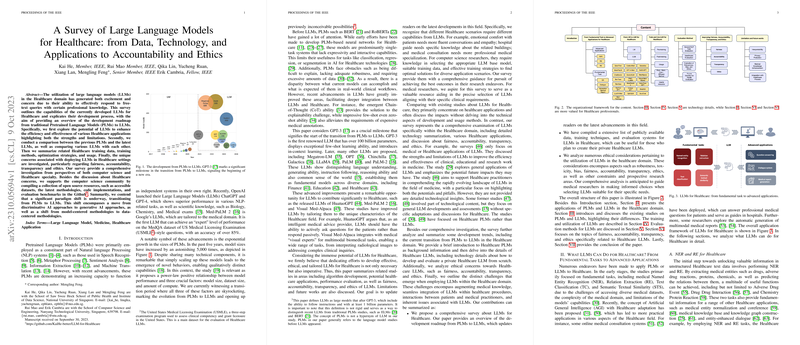LLMs in Healthcare: A Comprehensive Overview
The paper "A Survey of LLMs for Healthcare: from Data, Technology, and Applications to Accountability and Ethics" provides a detailed examination of the development, application, and implications of LLMs in the healthcare domain. It thoroughly explores the shift from Pretrained LLMs (PLMs) to LLMs, contrasting their distinctive characteristics and emphasizing the growing applicability of LLMs. This survey is significant as it captures the nuances of integrating advanced AI technologies into healthcare, focusing on the technical, ethical, and practical dimensions.
Initially, the paper delineates the transition from PLMs to LLMs, emphasizing a substantial paradigm shift from discriminative to generative AI, alongside a shift from model-centered to data-centered approaches. The authors argue that while PLMs served foundational tasks like Named Entity Recognition (NER), Relation Extraction (RE), and Text Classification (TC), LLMs exhibit potential for more advanced applications, such as question answering and dialogue systems that imitate clinical interactions. They propose that LLMs enhance efficiency and effectiveness through their emergent capabilities like contextual reasoning and instruction following.
Healthcare-specific adaptations of LLMs are highlighted, including the development of models that incorporate medical knowledge bases or specialized training from healthcare text corpora. The paper compares multiple LLM implementations like Med-PaLM and GatorTron, evaluated on healthcare-specific datasets such as USMLE and PubMedQA. A significant finding is that these models demonstrate increased proficiency in medical comprehension tasks, narrowing the gap to human-level performance.
The authors extensively investigate ethical considerations, notably fairness, accountability, transparency, and ethics in deploying LLMs in healthcare. They argue for addressing biases that may be embedded in training data and propose mechanisms for enhancing model accountability through transparency measures. This aligns with global discussions on the responsible use of AI, which is accentuated when dealing with sensitive health information.
Robustness and adaptability of LLMs are additional concerns that are addressed. The paper underscores the need for models to remain reliable amidst diverse and unforeseen inputs, a critical aspect when the stakes involve health outcomes. Moreover, the potential of these models to produce hallucinatory outputs or confabulation of information mandates stringent evaluation to ensure factual accuracy and reliability.
The implications of this research are multifaceted. Practically, it highlights the potential to enhance healthcare delivery through AI-driven efficiency and accuracy. Theoretically, it opens avenues for future AI research to focus on refining the complex decision-making capabilities intrinsic to healthcare environments. For policymakers and stakeholders, the synthesis offered by the paper could guide the formulation of guidelines and standards ensuring technology adoption that aligns with ethical and professional practices in healthcare.
Moreover, the paper speculates on future developments highlighting the significance of multimodal LLMs and AI agents as promising areas. The integration of visual data alongside text could transform diagnostic and consultative processes significantly. The authors also foresee a critical role for AI agents that may autonomously perform complex tasks, streamlining operations within healthcare settings.
In summary, this paper provides a meticulous exploration of LLMs in healthcare, articulating both technological advancements and associated challenges. By offering a comprehensive investigation from data, technology, and applications to accountability and ethics, it sets a grounded foundation for the responsible use of AI in healthcare. The insights gathered underscore the transformative potential of LLMs, while also cautioning the need for responsibly navigating the complexities associated with these powerful tools.
